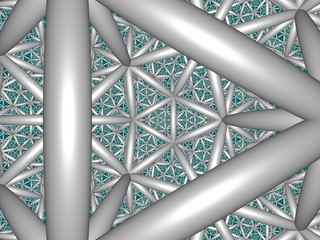
In mathematics, the Fibonacci numbers, commonly denoted Fn, form a sequence, called the Fibonacci sequence, such that each number is the sum of the two preceding ones, starting from 0 and 1. That is,

In geometry, a regular icosahedron is a convex polyhedron with 20 faces, 30 edges and 12 vertices. It is one of the five Platonic solids, and the one with the most sides.

In mathematics, a sequence is an enumerated collection of objects in which repetitions are allowed and order does matter. Like a set, it contains members. The number of elements is called the length of the sequence. Unlike a set, the same elements can appear multiple times at different positions in a sequence, and order does matter. Formally, a sequence can be defined as a function whose domain is either the set of the natural numbers or the set of the first n natural numbers.
A highly composite number is a positive integer with more divisors than any smaller positive integer has. The term was coined by Ramanujan (1915). However, Jean-Pierre Kahane has suggested that the concept might have been known to Plato, who set 5040 as the ideal number of citizens in a city as 5040 has more divisors than any numbers less than it.
1000 or one thousand is the natural number following 999 and preceding 1001. In most English-speaking countries, it is often written with a comma separating the thousands unit: 1,000.
300 is the natural number following 299 and preceding 301.
500 is the natural number following 499 and preceding 501.
700 is the natural number following 699 and preceding 701.
600 is the natural number following 599 and preceding 601.
800 is the natural number following 799 and preceding 801.
In elementary number theory, a centered square number is a centered figurate number that gives the number of dots in a square with a dot in the center and all other dots surrounding the center dot in successive square layers. That is, each centered square number equals the number of dots within a given city block distance of the center dot on a regular square lattice. While centered square numbers, like figurate numbers in general, have few if any direct practical applications, they are sometimes studied in recreational mathematics for their elegant geometric and arithmetic properties.
The centered polygonal numbers are a class of series of figurate numbers, each formed by a central dot, surrounded by polygonal layers with a constant number of sides. Each side of a polygonal layer contains one dot more than a side in the previous layer, so starting from the second polygonal layer each layer of a centered k-gonal number contains k more points than the previous layer.

1,000,000,000 is the natural number following 999,999,999 and preceding 1,000,000,001. One billion can also be written as b or bn.

A centered nonagonal number is a centered figurate number that represents a nonagon with a dot in the center and all other dots surrounding the center dot in successive nonagonal layers. The centered nonagonal number for n is given by the formula

A centered decagonal number is a centered figurate number that represents a decagon with a dot in the center and all other dots surrounding the center dot in successive decagonal layers. The centered decagonal number for n is given by the formula

A regular icosahedron has 60 rotational symmetries, and a symmetry order of 120 including transformations that combine a reflection and a rotation. A regular dodecahedron has the same set of symmetries, since it is the dual of the icosahedron.

The icosahedral honeycomb is one of four compact regular space-filling tessellations in hyperbolic 3-space. With Schläfli symbol {3,5,3}, there are three icosahedra, {3,5}, around each edge, and 12 icosahedra around each vertex, in a regular dodecahedral, {5,3}, vertex figure.
In mathematics, a Delannoy number describes the number of paths from the southwest corner of a rectangular grid to the northeast corner, using only single steps north, northeast, or east. The Delannoy numbers are named after French army officer and amateur mathematician Henri Delannoy.

A centered octahedral number or Haüy octahedral number is a figurate number that counts the number of points of a three-dimensional integer lattice that lie inside an octahedron centered at the origin. The same numbers are special cases of the Delannoy numbers, which count certain two-dimensional lattice paths. The Haüy octahedral numbers are named after René Just Haüy.
An icosahedral number is a figurate number that represents an icosahedron. The nth icosahedral number is given by the formula









